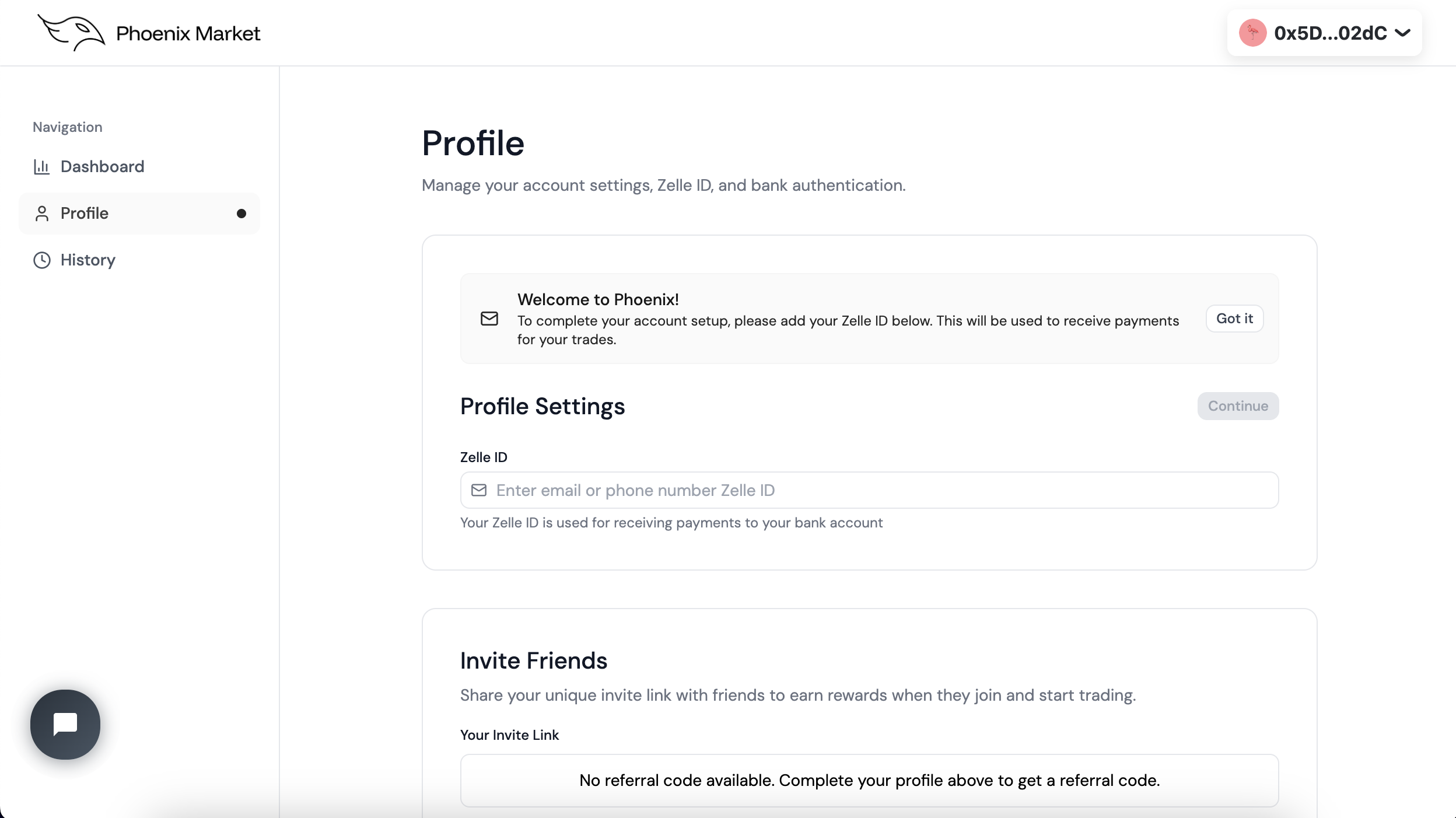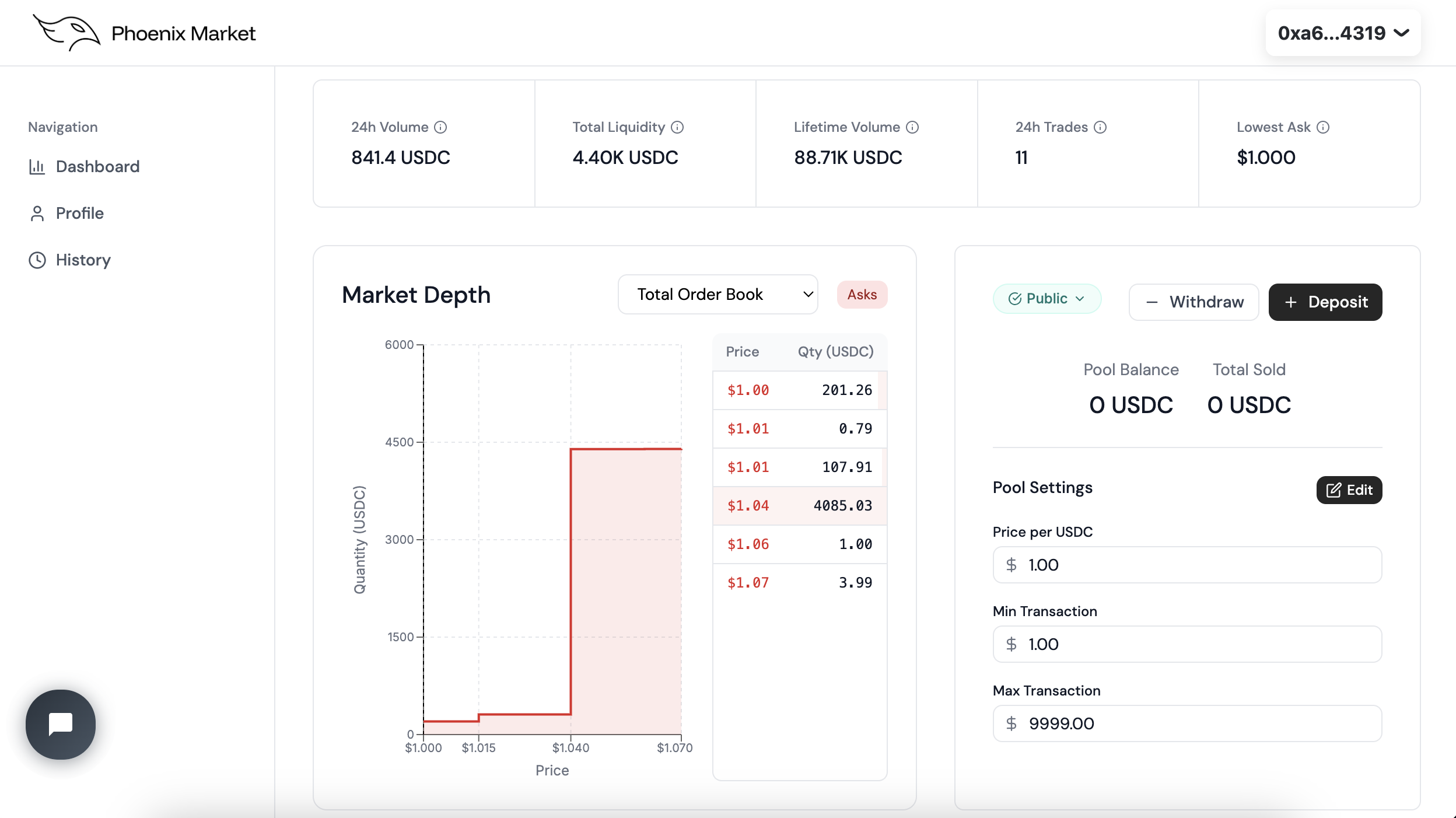The best way for integrators to guarantee sufficient USDC liquidity for their onramp users is to provide that USDC themselves as sellers on Phoenix Market, or by onboarding other sellers that can provide sufficient liquidity to match the buy volume they plan on bringing to our market.
Overview
Phoenix Market operates as a peer-to-peer marketplace where users can swap between USD and USDC. As an integrator, ensuring your users have access to sufficient USDC liquidity is crucial for a smooth experience. This guide explains how you can become a seller or onboard other sellers to provide the necessary liquidity for your users.Becoming a Seller on Phoenix Market
Prerequisites
Before signing up as a seller, ensure you have:- A Web3 wallet (MetaMask, WalletConnect, etc.)
- USDC on the Base network
- A Zelle account for receiving USD payments
- A bank account that can connect with Teller
- A referral code (we provide special codes for integration partners)
Special Referral Codes RequiredTo create a private seller network, you’ll need a special integrator referral code. You can request this by:
- Emailing us at main@phoenix.market
- Including your company name, intended use case, and expected monthly transaction volume
- We’ll respond within 1 business day with your referral code and additional integration support
Step-by-Step Seller Registration
1
Get Referral Code
Contact us to receive a special referral code for integration partners
2
Access Seller Dashboard
Visit https://trade.phoenix.market/invite and enter your referral code
3
Connect Wallet
Connect your crypto wallet to the seller dashboard
4
Setup Zelle ID
Configure your Zelle ID on the profile page for receiving USD payments
5
Connect Bank
Sign into your bank account using Teller on the profile page
6
Configure Pool Settings
Set your desired price/spread, minimum transaction amount, and maximum transaction amount on the dashboard

The profile page allows sellers to configure their Zelle ID and connect their bank account through Teller for receiving USD payments.
Pool Configuration
Once registered as a seller, you can customize your pool settings on the dashboard:Key Settings
- Price/Spread: Set your desired markup above the market rate
- Minimum Transaction: Smallest order size you’re willing to accept
- Maximum Transaction: Largest order size you can fulfill
- USDC Management: Deposit USDC from your crypto wallet directly into your seller pool, or request withdrawals at any time

The seller dashboard allows you to configure your pool settings, deposit USDC funds, and request withdrawals at any time.
Profit Model
Sellers profit by charging a spread on their USDC pool. For example:- Market rate: 1 USDC = $1.00
- Your spread: 1 USDC = $1.02 (2% markup)
- Profit per transaction: 2% of the transaction value
As an integrator, you have full control over the spread charged to your users only when you bring all your own liquidity. This means either becoming a seller yourself or onboarding your own sellers. You must also set up exclusivity between your buyers and sellers through the steps described in the “Creating a Private Seller Network” section. Without exclusive networks, your users will be matched with public sellers who set their own spreads.
How Our Matching Engine Works
Order Book System
All sellers are automatically added to Phoenix Market’s order book. When a buyer creates an order:- Order Creation: Buyer specifies amount and wallet address
- Order Book Query: Matching engine searches for compatible sellers
- Seller Filtering: Only publicly listed sellers with sufficient liquidity are considered
- Price Selection: Engine selects the seller with the lowest price/spread
- Tie Breaking: If multiple sellers have the same spread, selection is random
Matching Criteria
- Sufficient Liquidity: Seller must have enough USDC to fulfill the order
- Public Listing: Seller must be publicly visible in the order book
- Price Competitiveness: Lower spreads get priority
- Transaction Limits: Order must fall within seller’s min/max limits
Creating a Private Seller Network
Integrators can create private networks of sellers specifically for their users, ensuring better control over liquidity and user experience.Step 1: Get Your Referral Code
- Contact us to receive a special integrator referral code
- Distribute this referral code to sellers you want to onboard
- Any seller who signs up using your referral code will be automatically associated with your integration
We provide special referral codes for integration partners. Any seller who signs up using your referral code will be automatically associated with your integration.
Step 2: Configure Seller Privacy
Sellers in your network can control their matching preferences from the seller dashboard:- Privacy Toggle ON: Seller only matches with your users/buyers
- Privacy Toggle OFF: Seller matches with both your users and public buy orders
Step 3: Enable Private Matching
Add theonlyPrivateMatching=true parameter to your iframe URL:
When using private matching, if your seller network runs out of liquidity, your buyers’ orders will automatically fall back to public sellers on our market. However, we cannot guarantee competitive pricing in this scenario since public sellers set their own spreads independently.
Private Network Requirements
For complete privacy between your sellers and buyers:- Seller Configuration: Sellers must set their listing status to “Private” on the dashboard
- Iframe Parameter: Pass
onlyPrivateMatching=truein the iframe URL parameters - Access Token: Your access token differentiates your users from other integrators

Sellers can toggle their listing status to “Private” from the seller dashboard to ensure they only match with your users.
Benefits of Private Networks
Guaranteed Liquidity
Ensure your users always have access to USDC when they need it
Better User Experience
Faster transactions and more reliable service for your users
Revenue Sharing
Earn from the spreads charged by sellers in your network
Quality Control
Onboard trusted sellers who meet your quality standards
Competitive Pricing
Control pricing through your network of sellers
Brand Protection
Maintain your brand reputation through trusted seller relationships
Planning Your Liquidity Strategy
Initial Setup
- Volume Assessment: Estimate your expected buy volume and peak demand periods
- Seller Recruitment: Onboard enough sellers to cover your projected volume with a buffer
- Pricing Strategy: Work with sellers to set competitive spreads that are acceptable for your users
Ongoing Management
- Monitor Liquidity: Track USDC levels across your seller network
- Seller Communication: Ensure sellers refill their liquidity pools when they run low
- Performance Tracking: Monitor transaction success rates and seller reliability
Liquidity management is ongoing. Regular communication with your sellers about maintaining their USDC pools is crucial for reliable service.
Support and Resources
For assistance with seller onboarding and private networks:- Referral Codes: Contact us for special integration partner codes
- Technical Support: Get help with dashboard setup and configuration
- Seller Onboarding: Assistance with recruiting and managing sellers
- Integration Support: Help with iframe parameters and testing
We’re committed to helping integrators build successful USDC onramp experiences. Contact us to discuss your specific liquidity needs and get started with your private seller network.

